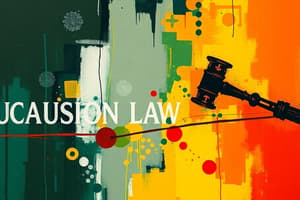Podcast
Questions and Answers
What is required to prove causation statistically under Daubert?
What is required to prove causation statistically under Daubert?
- The rate of injury must be less than the background rate.
- The rate of injury must be more than two times the background rate. (correct)
- The rate of injury must be at least five times the background rate.
- The rate of injury must be equal to the background rate.
Which of the following is NOT a criterion for the scientific validity of expert testimony according to Daubert?
Which of the following is NOT a criterion for the scientific validity of expert testimony according to Daubert?
- It should be generally accepted in the scientific community.
- It must be tested and published in reputable journals.
- It should be based on anecdotal evidence and personal experience. (correct)
- It must produce results within a predetermined error margin.
What must be proven regarding the accused in a legal case involving causation?
What must be proven regarding the accused in a legal case involving causation?
- The accused must be proven guilty beyond a reasonable doubt.
- The accused was the sole cause of the injury.
- The accused must have caused the injury independently.
- The accused caused the injury without independent factors. (correct)
In cases of dependent concurrent causes, what is the liability status for each party involved?
In cases of dependent concurrent causes, what is the liability status for each party involved?
What aspect of expert testimony is evaluated concerning its relevance in a legal case?
What aspect of expert testimony is evaluated concerning its relevance in a legal case?
What must a defendant's conduct satisfy to be considered a proximate cause of the plaintiff's injury?
What must a defendant's conduct satisfy to be considered a proximate cause of the plaintiff's injury?
Which test is commonly used to establish 'cause in fact' in negligence cases?
Which test is commonly used to establish 'cause in fact' in negligence cases?
Under what circumstance can a defendant still be held liable even if the injury would have occurred without their action?
Under what circumstance can a defendant still be held liable even if the injury would have occurred without their action?
What does 'negligence in the air is not negligence' refer to?
What does 'negligence in the air is not negligence' refer to?
Which doctrine might extend liability for negligence when a person's failure to act increases the risk of harm to another?
Which doctrine might extend liability for negligence when a person's failure to act increases the risk of harm to another?
What is required of the plaintiff to meet the burden of proof regarding causation in a negligence case?
What is required of the plaintiff to meet the burden of proof regarding causation in a negligence case?
What does the Frye Rule establish about the admissibility of scientific evidence?
What does the Frye Rule establish about the admissibility of scientific evidence?
Which legal principle emphasizes that it is the proximate cause that is considered in law, not the remote cause?
Which legal principle emphasizes that it is the proximate cause that is considered in law, not the remote cause?
Flashcards
Daubert Standard
Daubert Standard
A set of criteria used by judges to determine the admissibility of scientific evidence in court cases. It ensures that scientific evidence is reliable and relevant.
Scientific Validity
Scientific Validity
A key aspect of the Daubert Standard, ensuring that scientific evidence is based on sound scientific reasoning and methodology.
General Acceptance
General Acceptance
One of the Daubert criteria, asking if the scientific theory or technique is widely accepted within the relevant scientific community.
Peer Review and Publication
Peer Review and Publication
Signup and view all the flashcards
Independent Concurrent Causes
Independent Concurrent Causes
Signup and view all the flashcards
Cause in Fact
Cause in Fact
Signup and view all the flashcards
Necessary Condition
Necessary Condition
Signup and view all the flashcards
Substantial Factor Causation
Substantial Factor Causation
Signup and view all the flashcards
Loss of Chance Doctrine
Loss of Chance Doctrine
Signup and view all the flashcards
Proximate Cause
Proximate Cause
Signup and view all the flashcards
Proof of Causation
Proof of Causation
Signup and view all the flashcards
Frye Rule
Frye Rule
Signup and view all the flashcards
Expert Witness Testimony
Expert Witness Testimony
Signup and view all the flashcards
Study Notes
Cause in Fact (But For)
- Establishing causation requires demonstrating a "but for" relationship. The defendant's actions must be a necessary condition for the plaintiff's injury, meaning the injury wouldn't have occurred without them.
- The "but for" test asks: If not for the defendant's actions, would the injury have occurred?
- Cardozo's concept of "negligence in the air" highlights that negligence must directly cause the injury, not just be present.
- The "post hoc ergo propter hoc" fallacy (after this, therefore because of this) is a common error in causation analysis; it assumes a correlation implies causation.
Substantial Factor Causation
- If harm would have occurred in any event, but the defendant's actions were a "substantial factor" contributing to the harm, they can be held liable. It is sufficient that the challenged act is one "substantial factor" in bringing about the harm.
- Example: two fires merging to cause damage; both fire starters are liable as both were substantial factors.
Loss of Chance Doctrine
- This doctrine primarily applies to medical malpractice. If a medical professional's negligence reduces the plaintiff's chance of a favorable outcome, they may be liable.
Proximate Cause
- Proximate cause in law focuses on the foreseeable consequences of an act.
Burden of Proof: Causation
- The plaintiff has the burden of proving causation, by showing it is more likely than not that the defendant's actions caused the harm.
- Speculation is insufficient; probabilities alone do not establish causation.
Admissibility of Scientific Evidence
- The Frye standard (1923) required scientific evidence to have "gained general acceptance" in its field.
- Federal Rule of Evidence 702 establishes guidelines for expert testimony, focusing on relevance, methodology, and reliability.
- Daubert v. Merrell Dow shifted the focus from general acceptance to assessing scientific validity. Courts should consider factors like peer review, testability, error rates, and general acceptance.
- A plaintiff must show that a rate of injury caused by the defendant is more than twice the background rate for a statistically significant assertion of causation under Daubert.
Concurrent Causes
- Dependent: When multiple causes work together to create an injury; each party contributing can be liable for the totality of harm.
- Independent: When multiple causes, not necessarily linked, combine to create an injury; all contributing parties can be held liable. Each independent cause need not be the sole "but for" cause, but rather, merely a substantial factor in the outcome.
Studying That Suits You
Use AI to generate personalized quizzes and flashcards to suit your learning preferences.




